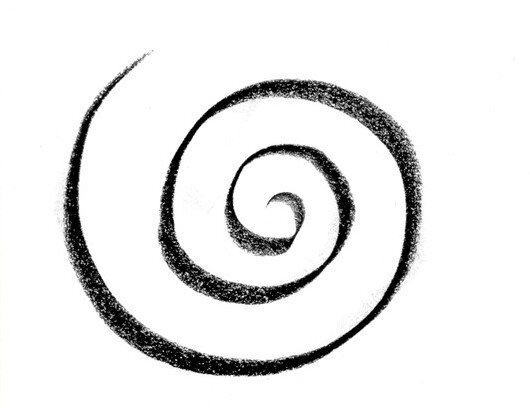The Primary Shapes in Guided Drawing: The Spiral
The structure of Guided Drawing is based on a number of primary shapes, which all have a universal, archetypal quality. A structured starting-point for fearful clients can be to practice one or two of the primary shapes, as instructed by the therapist. These movements can be taken into repetition, until clients feel confident enough to start on their own. Gradually many shapes come into play to tell their story. Another less directive beginning is to just flow with whatever the hands want to do in accordance with the client’s body-perception. In this case one will get a mixture of shapes that will want to be sorted and understood. In both cases clients experience a number of different movements which appear on the paper as shapes. The therapist, in addition, has the option of introducing certain shapes as a non-verbal intervention. Such interventions, drawn in repetition, will provoke a different felt sense, an option of change away from the helpless, overwhelmed, down-trodden, angry, terrified or dissociated state the client knows so well. This new felt sense may lead to reviewing old belief systems or simply practicing a different option to life.
The Human Body
Physiology: The spiral pattern of growth is found throughout nature as rolled-in fern, in shells on the beach, in the shape of an ear, in a fingerprint, the umbilical cord and how an embryo is curled up in the womb.
“Both the winding forms of the intestines and the brain have been depicted in religious and symbolic art as the labyrinth of spiral path, which creates, protects, and lays the foundation of the new town or centre”. (Purce 1992)
Hindu yoga practice focuses on the spiral movement of the kundalini up the spine through the chakras as ascending and descending path connecting heaven and earth. Many life-forming processes move spirally. (Purce 1992) The Milky Way is an ever-expanding spiral motion. A spiral always has a centre. All movement comes from this centre or returns to it.
“It is significant that, while the simple two-dimensional spiral is one of the most ancient symbols for eternity, it does not ever seem to have been a symbol for the Absolute. This is because it is not a whole; it can by its very nature never to be complete.” (Purce 1992)
The Labyrinth
Archetype: For the Hopi Indians the labyrinth was the ‘Mother Earth’ symbol, and they likened it to their own underground sanctuaries, the Kivas. It was from there that the Hopi emerged from the preceding world. In the Gnosis, a medieval branch of Christian mysticism it is the serpent or dragon, which coils around the World Tree or the central axis of the world, the Axis Mundi. The spiral is the ‘third’ entity that springs from the unification of the Great Parents. It is the divine child, the unfolding Self.
Neolithic pots as symbols of the body and the womb were often decorated with spirals: “The labyrinth both creates and protects the center, and allows entry only on the correct terms. Entry is thus initiation, a step on the path of knowledge. But before knowledge is revealed, the old perceptions must be dissolved by re-entry into the preformal state of the womb.” (Purce 1992)
Intervention: The dynamics of the spiral as a motor impulse in Guided Drawing are similar to what has been discussed with regards to the shape of the circle. Also here, the spiral may appear as the peacefully expanding centre of a mandala, or accelerate with frightening pull into a trauma vortex.
Guided Drawing of the spiral works with three major themes: the balance of contact between the inner and the outer world, the ability to concentrate and focus, and one’s personal experience of unfolding.
References:
Elbrecht, Cornelia. 2018. Healing trauma with guided drawing; a sensorimotor art therapy approach to bilateral body mapping. Berkeley, CA: North Atlantic Books.
—. 2006. The transformation journey. Todtmoos-Ruette: Johanna Nordlaender Verlag.
Purce, Jill. 1992. The Mystic Spiral. London: Thames and Hudson.












